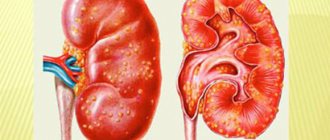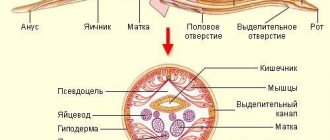Scarlet fever is a serious infectious disease that usually develops in children under ten years of age in an acute form. Its distinctive feature is the combination of multiple reddish rashes and sore throat. Scarlet fever appears due to a child being infected with group A streptococcus. This virus can also provoke the appearance of rheumatism, various kidney diseases, tonsillitis and chronic tonsillitis. The disease is transmitted by airborne droplets, through various common objects and food. In this case, an important factor in the development of acute scarlet fever is the child’s complete lack of immunity to streptococcal infection. Today we will tell you why scarlet fever appears in children, what its symptoms are and the incubation period.
Symptoms of scarlet fever in children, course of the disease
Scarlet fever is contagious, transmission of bacteria occurs through lubrication and droplet infection, that is, from coughing, sneezing and physical contact. After an incubation period of 1 to 5 days, the first signs of scarlet fever appear:
- The child complains of a sore throat and cannot swallow normally.
- High fever, headache, pallor and lethargy.
- The palate and tonsils are red. Yellowish plaques gradually appear on the tonsils, which may initially be absent.
- Change in skin color. A typical velvety-fine scarlet rash spreads from the groin and armpit area to the entire body. During the healing stage, there is peeling of the skin, especially on the fingers and toes.
- The area around the mouth is pale or bluish in color.
- The lymph nodes in the jaw area become painfully swollen.
- Scarlet or crimson tongue. With a streptococcal infection, it turns strawberry red after two to three days.
- A purulent runny nose occurs, as scarlet fever pathogens collect in the posterior nasal passages.
In severe cases of the disease, in addition to the infection, middle ear disease or sinusitis may occur.
Causes and routes of infection
Scarlet fever is dangerous because it manifests itself not only with sore throat, high fever, but also with rashes on the body. The combination of these factors leads to the development of complications. To avoid side effects, treatment of the disease should be started as early as possible.
Scarlet fever has been known to mankind since the 18th century. In those years, doctors described the symptoms of the disease, identified it as a separate infectious pathology, and treated it with special drugs. Modern scientists believe that the disease is bacterial in nature, the causative agent being group A beta-hemolytic streptococcus.
The process of infection and development of the disease:
- pathogenic flora, after penetrating the child’s body, begins active activity on the mucous membranes of the mouth;
- the first to appear are signs of a sore throat with characteristic rashes in the form of red dots on the throat;
- scientists describe cases of infection through damaged skin;
- the pathogen provokes the onset of an inflammatory process at the site of penetration;
- streptococcus enters the bloodstream and penetrates the lymph nodes;
- Only at this stage does the child feel the characteristic symptoms of scarlet fever. The reason is that a pathogenic microorganism, in the process of its life activity, produces special toxins and gradually poisons the body;
- the infection causes pathological changes in the tissues and organs of the baby’s body;
- Without proper treatment, the disease damages the health of the baby.
Thanks to numerous studies, scientists have proven that adults and children can be carriers of streptococcus. Carriers of streptococcus do not feel any symptoms, but they infect others. The pathogenic microorganism is actively released from the nasopharynx and throat mucus.
How to make it easier for a child to adapt to kindergarten? Read the advice of the professionals.
Treatment methods for hyperactivity syndrome in children are described at this address.
Infection with scarlet fever occurs in several ways:
- by airborne droplets;
- in close contact with an infected person (kissing, talking, coughing);
- contact and household (toys, towels, household items);
- through contaminated food;
- through wounds and abrasions on the skin;
- Scarlet fever can be a complication against the background of chronic diseases of the baby’s respiratory tract;
- with reduced immunity in a young patient, due to individual characteristics or after suffering a serious illness.
Some children are at risk due to the presence of certain factors:
- underweight;
- weakened immune system;
- chronic tonsillitis, atopic dermatitis;
- diseases of the endocrine system, diabetes;
- some forms of diathesis;
- HIV infection, AIDS.
READ ALSO: Inflammatory process of the external genitalia - vulvitis in girls: causes of development, methods of treatment and prevention of infection
How does the disease manifest itself?
Scarlet fever manifests itself in a child with a scarlet rash - this is how the body reacts to erythrotoxins, which are produced by streptococci, multiplying in the mucous membranes. The vessels dilate and red spots form. Such a clinic clearly indicates the symptoms of scarlet fever.
Here comes a combination of sore throat and red rash, which gradually covers the entire body. The rash starts from the head, like measles, and goes down. A characteristic picture of an external disease is the absence of a rash in the nasolabial triangle, redness of the cheeks and swollen cervical lymph nodes.
After the first days of illness, the scarlet rash disappears, the child may still look pale, with the exception of a crimson tongue and throat. If antibiotics are not taken, the young patient’s health may deteriorate, and after recovery, after 14 days, the disease may reappear.
Diagnostics
The pediatrician must examine the baby’s throat and skin and measure the temperature. Additionally, tests are taken to determine the presence of antibodies in the body to certain types of streptococci. Some specialists prescribe a general blood and urine test to fully study the clinical picture.
Most often, diagnosing an infectious disease is not difficult: characteristic signs make the task easier. An experienced doctor can easily determine the cause of the baby’s poor health and prescribe the necessary therapy.
The course of scarlet fever in children
In recent decades, scarlet fever in a child rarely causes complications. Thanks to antibiotic therapy, a varied diet, and the opportunity to receive timely medical care, children began to develop a more resilient immune system compared to previous decades, when this disease was considered dangerous and even fatal.
Light form
A mild form of scarlet fever manifests itself with moderate symptoms:
- Body temperature is less than 38°C;
- No vomiting, nausea or headache;
- The course of pharyngitis and tonsillitis passes without complications;
- The rash and peeling of the skin are mild.
With a mild form of scarlet fever in children, complications do not develop. The high fever subsides on the fourth day, and the rash and sore throat symptoms disappear on the sixth.
Average form of scarlet fever
Signs of the moderate form of childhood scarlet fever:
- Body temperature rises to 39-40°C;
- The child is chilling, there is weakness, pain in the head, repeated vomiting and nausea;
- Delusions and hallucinations due to a malfunction of the nervous system;
- The heart beats rapidly, the presence of tachycardia, pain in the chest area and shortness of breath;
- There is a yellow coating and sore throat on the tonsils;
- Excessive red rashes and subsequent peeling of the skin.
Symptoms in the moderate form last up to 8 days, during which the fever persists. In the moderate form, complications are possible, so the child is placed in a hospital under the supervision of doctors.
Severe form of scarlet fever in children
Modern antibiotics and improved immunity (compared to the past) resist severe scarlet fever. Its symptoms include:
- Increased temperature (up to 40°C);
- Nausea, dizziness, vomiting;
- Confusion, hallucinations;
- Severe, uneven rash;
- Complications of other diseases.
Important. Children with severe scarlet fever should be kept in hospital wards under the supervision of doctors.
When an infection enters the body, it begins to act without sparing the internal organs. The most common complications in severe forms are:
- otitis;
- development of purulent foci in the kidneys and liver;
- enlarged heart, low blood pressure, chest pain;
- joint pain and swelling;
- inflammation of the heart muscles;
- allergic reactions;
- glomerulonephritis;
- pneumonia.
Treatment regimen
How to treat scarlet fever in children? Pediatricians still treat the disease with penicillin antibiotics; other medications are used only in cases of individual drug intolerance. The duration of therapy is 5–7 days. During the course of treatment, the young patient is required to observe bed rest and a special gentle diet.
Why does a child walk on tiptoes and how to treat the pathology? We have the answer!
What should a 1 month old baby be able to do? Basic development skills are described in this article.
Follow the link https://razvitie-malysha.com/zdorovie/bolezni/allergii/krapivnitsa.html and read about methods of treating urticaria in children.
Treatment regimen for children with scarlet fever:
- a mild form of an infectious disease can be treated at home. For a small patient, allocate a separate room, ventilate it regularly, and do wet cleaning twice a day;
- necessary aspect - individual dishes, personal household items;
- Enrich your baby’s diet with the necessary amount of vitamins and microelements;
- For the first three days, food should be soft and liquid to avoid injury to the mucous membranes of the mouth and throat.
READ ALSO: Symptoms and first signs of rotavirus infection in children: treatment and prevention of dirty hands disease
Home Remedies and Recipes
In addition to medications, it is allowed to use traditional medicine recipes. Natural formulations complement the main therapy. When properly prepared and used, natural remedies are absolutely harmless to the child’s body. Consider the tendency to allergic reactions.
Effective recipes:
- cedar tincture. Pour 100 g of raw material with a liter of boiling water, let it brew for half an hour. Give the resulting decoction a tablespoon at a time. Frequency – up to five times a day. Treatment lasts about a week;
- valerian. Grind the valerian root, give the resulting powder to the baby 2 g several times a day;
- lemon acid. For a glass of warm water, take half a teaspoon of citric acid. The baby should gargle with the resulting solution in the morning and evening. This folk remedy will relieve the young patient of red spots, relieve swelling, and make the process of eating easier;
- Blueberry decoction. Pour boiling water over 100 g of leaves and fruits, simmer over low heat for 10 minutes. Cool the resulting product, strain, give the baby 50 ml three times a day, preferably after meals;
- parsley tincture. Take 150 g of fresh, finely chopped parsley, add 500 ml of boiling water, let it brew for one hour, filter. Lubricate the affected mucous membranes of the mouth, throat, and tonsils with the resulting decoction. Duration of therapy – 5 days.
Before using any traditional medicine, be sure to consult your pediatrician. Experts do not recommend treating a child on your own.
Treatment of scarlet fever in children with antibiotics
Treatment should always be prescribed by a doctor - after examination and passing the necessary tests. The prescribed drugs depend on the form and course of the disease. Scarlet fever in a child is usually treated with an antibiotic.
The most commonly prescribed drugs are amoxicillin or azithromycin. If this is a severe form of scarlet fever, cephalosporins are prescribed. Antihistamines are also prescribed - Tavegil, Suprastin, and, if necessary, antipyretic drugs (except aspirin).
To avoid detoxification, vitamins B and C are prescribed. If there is a cough, expectorants are prescribed, for example, Pectolvan C. To avoid hemorrhage, the doctor may prescribe ascorutin - it strengthens the walls of blood vessels.
If possible, the throat should be treated with chlorhexidine solution. Inhalations with Decasan are performed.
In addition, adequate rest and drinking plenty of fluids are important to help the antibiotics fight the disease. Previously typical consequences of scarlet fever, such as rheumatic fever, inflammation of the kidneys or inflammation of the heart muscle, which mainly occurred in the third week of the disease, have now become extremely rare thanks to antibiotic therapy.
Among the folk remedies, the child is given warm milk in unlimited quantities and drops of valerian - 1 drop for 1 year of the child’s life.
Scarlet fever becomes contagious during the first 24 hours after starting antibiotic therapy.
Prevention of scarlet fever in children
The best protection against this disease is washing your hands with antibacterial soap. You should also always treat a sore throat to the end to avoid scarlet fever infection. Good disease prevention is hardening the child, walking in the fresh air, morning exercises and a balanced diet.
If you suspect scarlet fever, you should always consult a doctor. He can assess the risks and severity of the infection. If antibiotics are not prescribed, the course of the disease should be monitored by a doctor so that possible complications can be identified in a timely manner.












